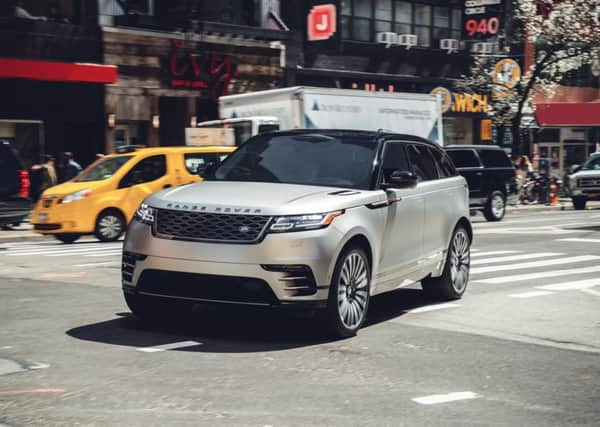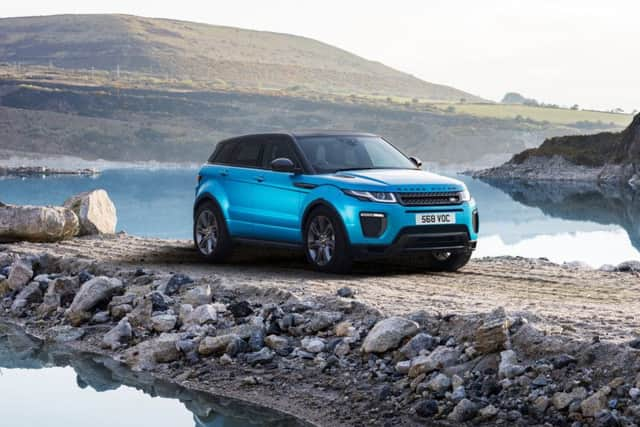Review: Range Rover Velar and Evoque


Oh dear. Well, in rescuing the Velar from these attacks I have to savage another Land Rover product, that latest Discovery. It is brilliant off-road but my beef with the Discovery is its back end. The dome-like rear is ugly and the offset number plate is never going to look OK. I have interrogated owners and they agree – but, hey, it seats seven, and will go anywhere.
The Velar? It is a streamlined Range Rover, and yes, I didn’t like the first one I saw. If Range Rover built a large saloon car, then this is what the estate could look like.
Advertisement
Hide AdAdvertisement
Hide AdIt has all the off-road magic and technology of the other big Range Rovers, can wade through two feet of water, etc. Most of these “functions” are controlled using one of two “swipe” screens which dominate the central part of the dashboard. At first they look daunting. In use, they are easy.


Apart from the Evoque, the Velar is the smallest and lightest Range Rover. At 189 inches/4.8m it looks longer than the Range Rover Sport but that’s an illusion caused by its lower height. (It is only an inch higher than an Evoque.)
The cheapest Velar at £45,000 undercuts its kin, but with a smaller engine. Like for like the Range Rover Sport is the next most affordable, with a margin of some £7,000 but as model designations are different it’s not easy to tell. In brief, it’s cheaper and lower than a Sport, but a lot larger and pricier than an Evoque. And it can get very pricey. My Velar First Edition P380 automatic (380ps supercharged three litre V6 petrol) cost around £85,000.
Did it wallow? Not a bit. The handling is balanced and reassuring, making it the sportiest of the Range Rovers. The lower centre of gravity means that if you are barrelling into corners you don’t need to fight the weight and body lean. At 1,884kg, a Velar is a few hundred kilos lighter than the Sport.
Talking points include the opulent interior and the convenience of the pop-out door handles, which retract as you drive off. There are exterior decorations, the equivalent of a tasteful body jewel, blimps on the bonnet, more along the cheeks, racy side fins in the front valance, raised block lettered Range Rover script on a band under the rear window.


Greenery: the factory figures are 0-60mph in 6.3 seconds, 30.1mpg and 214g CO2 so I should be happy with my average of 26mpg. On that basis the tank range is around 350 miles.
The car which started the current design phase at Range Rover is the Evoque, now into its seventh year and still a phenomenal success in the teeth of serious and improving competition. Another is in planning, and the company hasn’t denied the arrival of an even smaller model. After time in the Velar, the Evoque ride quality was noticeably coarser. After a few days the memory faded.
Its looks are imposing, maybe divisive. Not everyone likes its adventurous shapes, which time hasn’t mellowed, just made more common. Sitting inside, you don’t notice because it feels so good.
Advertisement
Hide AdAdvertisement
Hide AdLand Rover – which makes the Evoque in Liverpool alongside the cheaper but less flashy Discovery Sport – loaned me the Autobiography version. This is posh frock stuff, which with the weakest 180hp diesel engine and a nine-speed automatic gearbox costs more than £50,000. However, you can buy an Evoque for £30,760. That one has front-wheel-drive and a 150hp diesel, which does the job for most drivers. The 4x4 versions start at £33,360 with the 180hp diesel. You can now have the latest improved “ingenium” units – a 240hp diesel or 240hp and 290hp petrol. All are four cylinder, 2-litre engines. Prices here are for the five-door model. There’s a three-door “coupe” which is less practical and more money. For the boulevardiers there’s a two-door convertible, from £45,250.
There’s no doubt the Autobiography is class. The stitched leather furnishings made visitors gasp. So did the puddle light, which projects on to the ground outside the front doors a circle of light enclosing an outline of the Evoque. On start-up, the green Land Rover oval appears in the head-up display – which projects road speed and navigation details on to the windscreen: £1,035 please.
This small SUV is nimble and grippy on curvy twists. For slippery or off-road work there is a choice of three terrain settings, using a diagrammatic selector and you let the vehicle’s brain do the rest.
The only disappointment was its fuel consumption. The brochure suggests around 46mpg in town, 63mpg out of town and 55mpg overall, with CO2 of 134g/km. The lowest recorded by the trip computer was 30mpg in urban and local driving, a dismal 34mpg on my usual commute route and 42mpg on the motorway.
Verdict: Perfect pair for the Range Rover set.